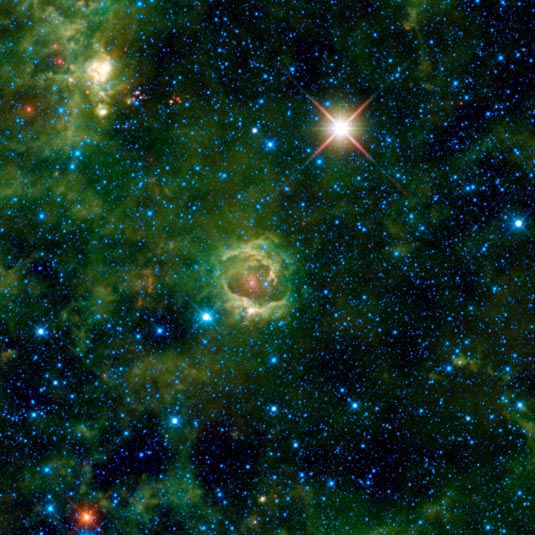
Description: Emission Nebula> HII Region
Position(J2000): RA: 23h 39m 18s Dec: +61° 56'
Constellation: Cassiopeia
Distance: 6,200 light-years (LBN114.55+00.22); 18,000 light-years (HIP117078)
Size: 30 light-years
Field of View: 0.46 x 0.46 degrees
Orientation: North is 224.75 degrees left of vertical
Image Credit: NASA/JPL-Caltech/WISE Team
Release Date: Sep 16, 2010
ABOUT THIS IMAGE:
Nebulae are enormous clouds of dust and gas occupying the space between the stars. Some have pretty names to match their good looks, such as the Rose nebula, while others have much more utilitarian names. Such is the case with LBN 114.55+00.22, seen here in an image from NASA's Wide-field Infrared Survey Explorer, or WISE.
Named after the astronomer who published a catalogue of nebulae in 1965, LBN stands for "Lynds Bright Nebula." The numbers 114.55+00.22 refer to nebula's coordinates in the Milky Way Galaxy, serving as a sort of galactic home address.
Astronomers classify LBN 114.55+00.22 as an emission nebula. Unlike a reflection nebula, which reflects light from nearby stars, an emission nebula emits light. High-energy light blasted out from a nearby massive star strips away electrons from the nebula's hydrogen gas, causing the gas to become charged. These nebulae are also called HII regions, with the "H" standing for hydrogen and the "II" indicating that the gas is ionized. As the ionized gas begins to cool from a higher-energy state to a lower-energy state, it glows. In the case of LBN 114.55+00.22, dust blocks the view of most of this nebula in visible light. But the dust of the nebula is also warmed by the light of the young stars within, and WISE's infrared detectors see its beautiful infrared colors. Emission nebulae are usually found in the disks of spiral galaxies, and are places where new stars are forming.
In the lower left corner of the image is the bright red star IRAS 23304+6147, which is in the last phase of its life. As the hydrogen in its core burns out, the star will become a planetary nebula, ejecting material that absorbs visible light and glows in the infrared. This star's name comes from the 1983 survey mission Infrared Astronomical Satellite (IRAS).
Another bright object in this image is the supergiant variable star HIP 117078, seen above and to the right of the nebula. In this case, HIP stands for Hipparcos, a European Space Agency satellite that catalogued the positions of over 100,000 stars.
The colors used in this image represent specific wavelengths of infrared light. Blue and cyan represent light emitted at wavelengths of 3.4 and 4.6 microns, which is predominantly from stars. Green and red represent light from 12 and 22 microns, respectively, which is mostly emitted by dust.